Hebrews 6:19 tells us that “we have this hope as an anchor for the soul, firm and secure”. As a Navy veteran, I love the picture that this verse uses of the anchor. Every ship has an anchor to hold it in place at the end of a day’s travel or to hold it steady during great storms. And, that is what we have done. We have placed our trust in Jesus Christ so that he can keep us grounded during the ups and the downs of life. He is, and always will be, our strength and our comforter.
We daily place our trust in God, the Creator of all things who knew us before we were born. We are so very thankful that He sent His son, Jesus Christ, to die for our sins. A loving act, that has saved us from eternal judgment. Our relationship with Jesus allows the Holy Spirit to dwell inside us and to teach us how to be more like Him. We look forward to the day that we get to see Jesus face to face. But, until that day, we will do our best to follow Him and take care of all that he has provided.
1 Comment
Why birds? For the eggs, of course! No other animal provides such a valuable and versatile benefit. Eggs can be used in cooking to add volume when whipped (soufflés, sponge cakes, marshmallows), as a thickener (custards, sauces), as a binding agent (to adhere bread crumbs, to hold meatloaf or crab cakes together), as an emulsifier (in mayonnaise, salad dressings, Hollandaise sauce), as a clarifier (soups, coffee), as a crystallization retardant (candy, frosting), as a glaze (breads, cookies), and as a garnish (hard boiled, deviled). For eating, eggs can be prepared in a variety of ways including fresh (raw, egg nog), fried (sunny side up, over easy, over hard, basted, steam basted, omelet), scrambled (breakfast burrito), poached (egg drop soup), hard boiled (egg salad), deviled, and baked (quiche, frittata). Eggs are considered the perfect protein source, and are classified with meat in the protein food group because they contain 18 amino acids, nine of which are essential to the daily needs of the human body.
Not only do eggs have great nutritional value, but they also have a wide variety of other uses, such as:
Eggs are not the only reason that we choose to keep birds. It is easier to raise poultry on a small parcel of land than it is for most of the larger livestock. Poultry do not require much space to be comfortable, safe, and to thrive. For example, a chicken only needs 3-4 ft2 for housing, 10 ft2 for exercise, and do not need any access to pasture. This means that an expensive and expansive electric fence is not required. They do, however, need the exercise and housing areas to be secure from predation, which takes time, requires monitoring, and has some expense. Birds have unique personalities and behaviors that make them fun to spend time with. The larger birds remember who they see frequently, especially those bringing treats. Their dietary range is vast, making it fun to give them nearly everything that would otherwise go down the garbage disposal. The smaller birds have shorter memories, but know a treat when they see it. I always get a chuckle seeing the quail jump up and down at a fevered pace when I deliver the days’ sunflower sprouts. Also, no matter how old the quail are, when I walk into the coop the cockerels always ensure each of his hens are serviced before their perceived impending doom.  In the most primal sense, everything begins with a hunger. We have a hunger for growing and raising good food, which is at the heart of what we do. Second Journey Farmstead is committed to organically growing fruits, nuts, and vegetables, along with humanely raising livestock and poultry. This means that we do not use pesticides or herbicides in the garden or orchard, or use antibiotics, growth hormones, or preservatives in the livestock or its meat. It also means that we hold all life in high regard, and treat it as a precious gift. This includes feeding a wholesome, nutritious, and diverse diet to our short-term guests, and dispatching by the quickest, most humane means possible. Our “second journey” is a transition from a career in the Navy to civilian life, but it also symbolizes a commitment to mentally transition from accepting low-quality mass-produced instant-gratification foods to one of deliberate intent to be more discerning in what we consume. Part of that transition involves becoming, as much as reasonably possible, the source of our own sustenance. Portions of the property have been designated for assignment, and are currently undergoing preparations to fulfill their tasks. We expect to have the orchard at full production by 2022. In the meantime, we will focus on meat, eggs, compost, and the garden.  We are passionate about ensuring the survival of heritage livestock and poultry breeds because they are beautifully unique, multi-purpose animals that have mostly been dismissed by large commercial interests. Being well-rounded, heritage breeds generally lack the excellence in any one particular category that commercial raisers look for. Another appeal of heritage breeds is that they are not raised to be oversized for their skeletal structure, a trait commonly found in commercially grown animals, which leads to poor health quality and shorter lifespans. Heritage breeds must be capable of reproducing on their own. Most of the commercial breeds raised for mass consumption cannot make these claims. They are selected for one purpose, and animal longevity, quality of life, or unassisted reproduction are not it. This is why we are proud to be lifetime members of The Livestock Conservancy, a non-profit organization who shares our dedication to the preservation and promotion of heritage breeds. Our passion for heirloom seeds matches our passion for heritage breeds. No matter which side of the GMO debate you fall on, you will likely appreciate that we seek to minimize or utterly remove all pesticide and herbicide use in our garden and orchard. This may complicate pest and weed eradication, but it also means no GMO seeds for us. Our output may suffer, but we are willing to accept that consequence to ensure we are not ingesting herbicide or herbicide-ready chemicals through our food or water supply, and neither are our animals.
The birth of 18 little quail chicks was such an exciting time at Second Journey Farmstead. They were all so cute with their fluffy down, their inquisitive nature, and their wobbly legs. They would run to greet us as soon as they noticed us peering in on them, only to turn and flee when we opened the door and tried to touch them; all except for one. One of the chicks was born with the tendency to hold its legs straight. This made standing, let alone walking, impossible. While the other chicks ran around, this chick continued to lie down with its legs fully extended.  Not being able to walk meant that the chick could not get to its food and water, run from danger, or fight back when the other, stronger chicks started to peck at it. So began our family’s discussion about whether this chick could be saved or if it needed to be put down before it received any farther harm. And, with this debate, came the beginning of Anastasia’s heart break. Anastasia fought vehemently that, regardless of how slight the chick’s chances of leading a normal life, every effort should be put forth to save this tiny newborn chick. I am certain that almost every livestock owner has had this debate, at one time or another, with their children and, like us, they have been left with some of the hardest questions to answer: How do you explain to a child who still thinks that everything should be fair that sometimes life is not? How do you convey that sometimes babies are born damaged and that, in the animal kingdom, it really is survival of the fittest? How do we prepare our children for the eventual death of a baby that they have already fallen in love with because it is just so cute and that it needs someone to love it? So, when the chick was found dead the next morning, we did the only thing we could. We tried to comfort Anastasia through the tears.  Our first batch of hatching quail eggs went into lockdown mode on the afternoon of Good Friday. One of the problems mentioned in SJF Blog post 008 was our difficulty with maintaining proper humidity levels during this critical time period. A soaked sponge was placed directly under the circulation fan to aid in the effort. Despite these difficulties, it generally only took four hours for each hatched chick to clean itself and regain enough strength to be moved to the brooder. In an effort to ensure that nobody was alone in the brooder, we initially waited for at least two chicks to be ready to move before doing so. After that, they were moved once they were ready. We hovered with great anticipation each time one of the chicks started to break through its shell. To be honest, it was extremely difficult to restrain ourselves from helping when we saw one struggle to escape its confinement. The last one to hatch had the most difficulty, so we did end up having to assist it. But, what really got us excited was the fact that the hatch day was on Easter! This was completely unplanned. The date did not register when the eggs were set, only once they went into lockdown mode did we notice the coincidence. How fun it was to praise the resurrection of Christ in the morning and witness the chicks’ birth in the afternoon! 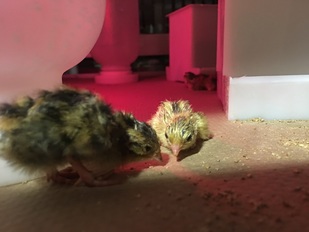 We started our first batch of hatching quail eggs with 21. Three were removed at candling on day six because they were not fertile. Two failed to pip and never made it to the brooder. Three more gave up the ghost in the first week. In all, 16 hatched successfully and were moved to the brooder. Originally, we were ecstatic with an 89% fertile egg hatch rate. Ultimately, 14 of the original 21 eggs made it to week two. That is a 72% fertile egg survival rate. Not too bad for our first hatch, considering all of the difficulties we had to work through with the desktop incubator/hatcher. 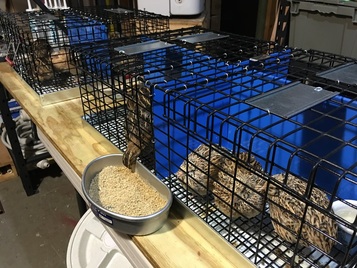 When we first brought the quail home we had not yet decided on how we were going to permanently house them. The logical choice seemed to be the three divided rabbit carriers that were not being used. Two of the cages have two chambers each and one has four. The space was small, but it allowed for separation of quail by color and gender. While they did fill the need, they were not the most ideal living arrangement for the quail. Cramped quarters lead to fussy birds and we can now say that we understand the origin of the word “henpecking”. Another disadvantage of using the rabbit carriers is that there is not much room between the floor of the cage and the removable tray underneath. This makes for little room for the bird poop to drop away from the birds. We discovered that the odors were greatly reduced with the installation of a liner. Puppy pads did the trick as long as they were changed frequently. We were excited to finally receive permanent housing for the quail because it meant that cleaning would be easier, the birds would have more room, and the eggs could roll out of the living area for a simpler and cleaner collection.  The birds’ time in their temporary housing was not without accident. One of the larger hens experienced a rather unusual injury when she broke off a large portion of her upper beak. There was a significant amount of blood loss which stopped before I had time to get a coagulant. It did, however, leave quite a mess all over the cage. She was quickly isolated to keep the other birds from pecking at her. We were also concerned that she may have problems eating and drinking since there was such a large difference in length between the upper and lower parts of her beak. Fingernail clippers were used to shorten the lower beak slightly. We are happy to report that she has made it through the ordeal and is now living a normal and productive life. 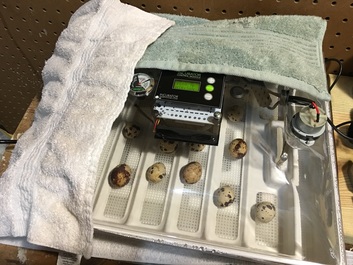 Our first incubator/hatcher was a fully automated desktop unit from Incubator Warehouse. We bought the one made of high density plastic over the other Styrofoam models because it would be easier to clean and disinfect properly after the hatch. Out of convenience, we set the incubator up in the basement where the temperature hovers at a constant 66ºF. The cooler atmosphere made it difficult for this small incubator to maintain the 99.5ºF temperature required for incubation. We wrapped the unit in towels to help keep the heating element from operating at 100% capacity. We were pleased with the hatch rate for our first batch, but have not been very pleased with the smaller unit’s performance for several reasons. One of the difficulties we noticed is that it takes a significant amount of time to return to temperature after the unit was opened for candling or adding water, even with towels in place to trap in heat. Another problem is that the humidity gauge is relatively worthless. It never read accurately and there is no good place to set a wet bulb thermometer so that it remains wet. According to the gauge, we never achieved the proper lockdown humidity level despite placing wetted sponges directly under the fan. Additionally, all of the eggs rested on their sides for the duration of the incubation and hatch. This may be a minor issue, but due to the disparity between the quail egg size, the large turning tray channel widths, and the short throw of the turning motor, I have serious questions about how well the eggs are actually being turned during incubation. Because of these concerns, and our desire to set multiple batches concurrently, we have since moved to a cabinet incubator and separate cabinet hatcher. They were expensive, but they address all of our concerns with the smaller incubator/hatcher while also automatically regulating humidity. 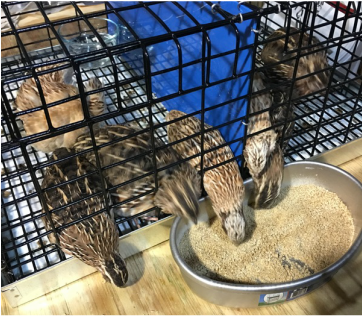 Our original plan was to begin the year by introducing rabbits onto the farmstead. We chose to use stackable cages because of the limited area in the barn, which is the best area for us to house the rabbits. Equipment was ordered from a reputable manufacturer with one of the best stackable rabbit cage designs. Unfortunately, the manufacturer, due to a series of nearly comical circumstances, is now five months behind in fulfillment of orders and apparently nobody is cancelling. To prevent our plan for this year from becoming seriously derailed, we have moved forward with the introduction of Coturnix quail to the farmstead. Our first batch of quail came from a nearby family that had them listed for sale on Craigslist. We bought 28 birds and soon discovered that the cock to hen ratio was much too high. Because males eat the feed but obviously do not produce eggs in return, eight of them quickly found their way to the dinner table. Let’s just say that the first meal was not the best. Cooking quail is similar to cooking chicken, but not exactly the same. We will need to experiment with different recipes and techniques to get it perfected.  Here is Anastasia holding our first egg. What an expensive egg that was! It took nearly two weeks for the hens to become relaxed enough in their new home to begin laying again. We were worried for the entire waiting period that we had bought birds that were just too old to lay. After sexing the birds and separating the cocks from each other, we paired them up with hens and began collecting fertile eggs. We were excited to amass our first batch for incubation, which will be discussed further in the next blog post.  Without going too far off the deep end, we see an ever-pressing need to be able to economically provide as much untainted, untreated food for our family as possible. We will reduce our dependency on the public food supply while reducing the myriad of pesticides, preservatives, and growth chemicals that we consume through our food. Simultaneously we will decrease our food bill while drawing us closer to God and His creation, and also creating a sense of security should something catastrophic happen in the future. Beyond meeting our own needs, we intend to sell select items to the public and also donate a portion to church functions and local homeless shelters. Each of us has at least one chronic medical condition that benefits from a reduction in processed foods and an increase in quality whole foods. Our family lives with a wide range of ailments including seasonal and food allergies, asthma, cold urticaria, eczema, high cholesterol, fibromyalgia, endometriosis, and even the loss of a gall bladder. Naturally grown and raised food sources help us reduce the impact these medical issues have on our lives. Providing for our own needs is an integral part of that, as we transition from a mostly mass-produced diet to one where we control the content of what we consume. It will not cure all of our ills, but the difference is noticeable and the satisfaction is incalculable. We value logical planning, hard work, determination, smart budgeting, open communication, honesty, fairness, family time, humor, humility, and faith. We strive to be better at each of these things every day. We aim for synergy within the family structure and, realizing that this is sometimes impossible, we also work to remain flexible. We love to spend time with extended family but, unfortunately, we do not live very close to any of our relatives. Hopefully, one day we will be able to realize a longstanding dream of living closer to our families. Until that day, we will make the most of what we have, where we are.  Our property is rather odd in that it is triangle shaped and has an average downward slope of 12 degrees from front to back. There currently are no earthworks to control water runoff, and there is a storm drain in the street at the front right corner of the property that dumps precipitation out near the swimming pool. We are on the North side of a hill, which receives more shade and further complicates our ability to grow some of the crops and trees that we desire. The red area is a permanent easement of the Columbia Gas Pipeline, on which we are not allowed to build any permanent structure. The picture to the right is of a 3D model that I created to depict how we want to utilize our property. It is beneficial to helping us plan the order in which changes must be made so that no effort is wasted, duplicated, or done prematurely. The area behind the barn, located at the center of the property, is yet to be developed. Our plan is to divide the area up into equal sections, or paddocks. A paddock system will effectively increase the property size as rotational grazing allows unused sections to recover more quickly. The areas with ponds are currently forested and the areas behind them were clear-cut and graded by the pipeline as a temporary easement. The goal is to be able to manage chickens, ducks, geese, turkeys, peafowl, and goats on the property in a paddock system and utilize the barn for raising quail and rabbits. We will do everything we can to minimize feed costs and waste, such as planting an orchard, planting edible forage within the paddocks, growing some of our own crops more abundantly as supplemental intake for the animals, sprouting grains as fodder, and composting. We also plan to keep bees on the property to provide a natural source of sweetener and to help with pollinating. The ultimate goal is to create an ecosystem where the individual parts work together in symbiosis for our benefit; basically, to make a thriving micro-farm. |
AuthorThis is a family affair. We all get involved in documenting our life in the woods. Archives
April 2017
Categories |
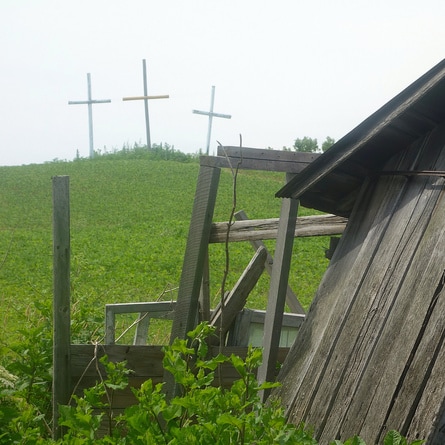



 RSS Feed
RSS Feed